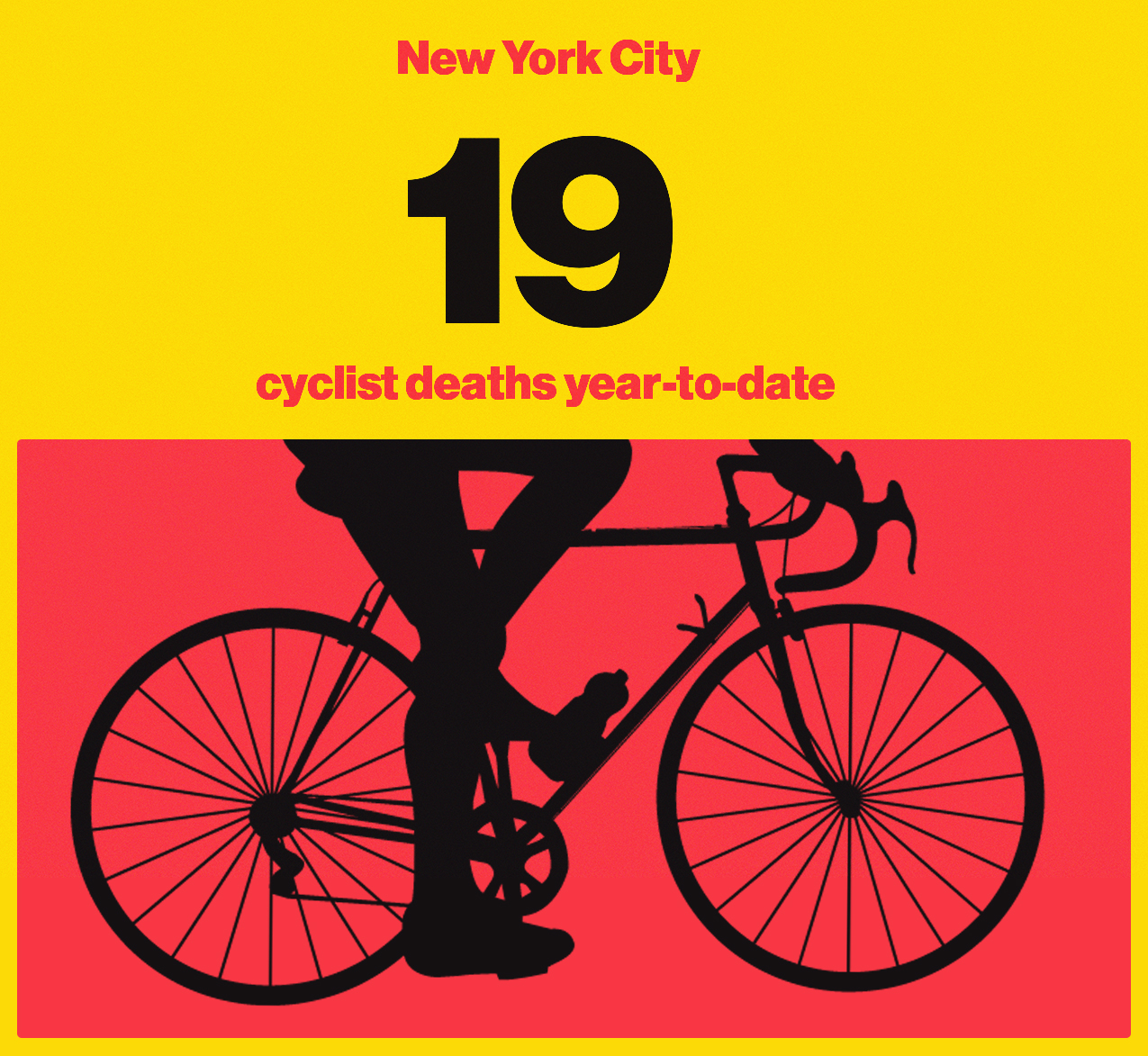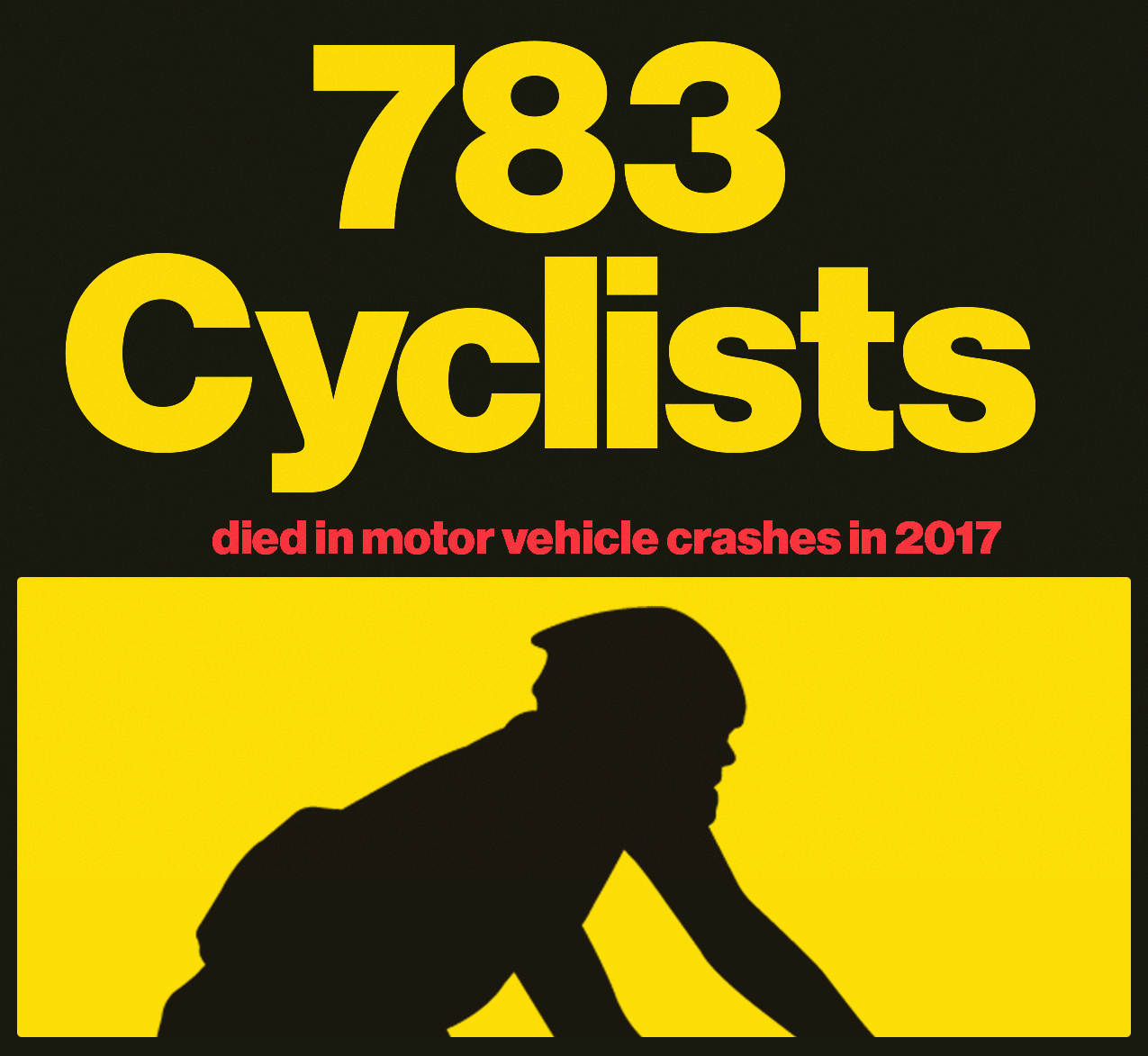In 2019, more and more cities across America are encouraging their residents to commute by bicycle. Cycling, of course, is good for the environment in terms of reducing pollution from car-dominant streets, and it’s a healthier way to travel.
But cities gaining new cyclists are quickly, tragically finding that they do not have the proper infrastructure to keep them safe. Cyclist fatalities have gone up 25 percent across the U.S. since 2010, and up 10 percent in 2018 itself, while all other traffic fatalities have decreased.
Videos by VICE
And it matters where you live: 75 percent of these cyclist deaths occur in urban areas. New York City became the most dangerous city for cyclists in 2019 with 19 deaths to date—almost double the total in 2018.

The major causes of cyclist deaths are motor vehicle crashes, and hit-and-runs and driver inattentiveness are unfortunately the most common factors. The most recent death in NYC was a collision between two cars and 52-year-old cyclist Jose Alzorriz at the intersection between Coney Island and L Avenues in Brooklyn last month. Alzorriz was pinned by an SUV that spun off the road after being struck by another driver who ran a red light.
Amanda Hanna-McLeer, 26—whose mother was Alzorriz’s partner—wants to make it known that lack of protections in place for cyclists hurts real people and families. This is the third family member Hanna-McLeer has lost to traffic violence in a 25-year span. Her aunt and grandmother were struck and killed by a hit-and-run driver while crossing the street. Their killer was never found or charged. “It was just horrifying to find that Jose just died, because it’s something you can never imagine could happen again in your family,” she said. “This really points to an epidemic.”
Hanna-McLeer said Alzorriz was a generous community man. He opened his home to a family who was being evicted, put down payments on apartments for friends who were struggling, and even paid for repairs and medical bills when any of his cycling friends got into accidents. “One cyclist told me that when he was in the hospital, he woke up in a haze to Jose cleaning his wounds,” Hanna-McLeer said. “It’s a loss for the community because he did so much for the community. We feel so cheated.”

On the West coast, Los Angeles has been similarly treacherous for cyclists. In 2018, the city had 21 cyclist deaths, up from 17 in 2015, when the city announced its Vision Zero plan, an initiative for a 20 percent reduction in fatalities by the end of 2017 and zero deaths on city roads by 2025. Vision Zero is an international road safety campaign, but cities have sought to tailor the basic tenets to their own needs and infrastructure. Or at least say they are.
Some of the biggest issues are unprotected bike lanes in major cities, which lead to cyclists getting thrown into traffic by dooring—when a driver or passenger opens a car door in the path of a cyclist. Dooring accounted for 203 cyclist accidents in San Francisco from 2012-2015.

In March, Airbnb employee Tess Rothstein, 30, was thrown from her bike and into oncoming traffic when she swerved to avoid an open door in the bike lane, and then was fatally crushed by a truck.
Rothstein was only one block away from a “protected stretch” where cyclists were guarded by parked cars, the San Francisco Chronicle reported after her death. “Tess Rothstein was riding down a narrow, poorly designed bike lane when she was killed,” said Dave Snyder, executive director of CalBike, the California Bicycle Coalition. “Basically the next day they fixed the configuration of that street and created a protected bike lane.”
Some cities, like San Francisco, are reactive when it comes to road safety for cyclists. Others are preventative, laying down clearly marked bike paths and putting up signage to make sure vehicle drivers are more aware before accidents can occur. But most cities, Snyder said, are “sitting on their asses doing nothing while thousands of people are getting killed.”

“It’s irresponsible. Most [cities] aren’t taking the traffic carnage seriously. That’s shameful enough on its own, considering the encouragement of reducing cars in our cities to reduce climate change,” he said.
Along with NYC and LA, some of the worst cities for cyclists are Houston, Texas, five cities in Iowa—including Webster City, Waterloo, Sioux City, Johnston and Des Moines—and Jamestown and Fargo, North Dakota, according to May analyses of city data by Your Local Security. Even though many of these cities are adopting Vision Zero initiatives, the rollout for changes in infrastructure are slow.
Southern Brooklyn, where 13 of the 19 deaths in NYC occurred, is an area that has been left out of the city’s Vision Zero plan, according to Cutrufo. “The roads look like they did a decade ago. Local community boards don’t support plans that would bring safe bike lanes,” he said.

“We need a 100 percent connected and protected network of bike lanes. There is no reason NYC can’t afford to do that,” Hanna-McLeer said of NYC’s Vision Zero plan. A strip of green paint on the street doesn’t protect anyone. It likely wouldn’t have saved Alzorriz, who was already abiding by the rules of the road. “If there was a protected bike lane where cars are parked and a cement block separating, he would have had a shot,” she said.
How are other cities doing it? Davis and Berkeley, California were ranked the safest cities for cyclists. “Perhaps the most salient factor [to bike safety] is the fact there are already lots of people riding bikes. There’s a safety in numbers mentality when riding bikes,” Snyder said of the two cities. Both Davis and Berkeley have also invested in safe cycling infrastructure—a large network of car-free paths and protected bike lanes.
The infrastructure is necessary, especially for beginner cyclists. Most people who ride don’t attend educational programs before getting on their bikes. “Most [cycling] behavior is learned from watching other people on bikes. It is imperative that the infrastructure is designed to steer people—literally—into safe behavior,” Snyder said.

New Haven, Connecticut, is another safe city for cyclists. The city laid out its first protected bike lane in 2017—a mile long, two-way, off-street “cycle track” separated from the main road by a curb. New Haven ranked as the 10th safest city nationally, and the safest city east of the Mississippi River, in the May report.
One other way to deter bicyclist fatalities is to start holding drivers responsible when they cause the accident, especially in cases of a hit-and-run. The Reckless Driver Accountability Act, which targets the top one percent most dangerous drivers in the city, was introduced to the New York City Council in 2018, and is said to be moving slowly toward Mayor Bill de Blasio’s desk. Data in NYC has shown that purposefully reckless drivers create a disproportionate amount of harm to cyclists, pedestrians and other vehicles on the road. Under the Act, repeat offenders would have their vehicles impounded.
The U.S. may always be a car dominant country, but Snyder is optimistic. “I have hope that we’re about to quickly change our systems,” One day drivers and cyclists may be able to share the road in peace. Until then, ride safe.
Follow Jada Butler on Twitter.




